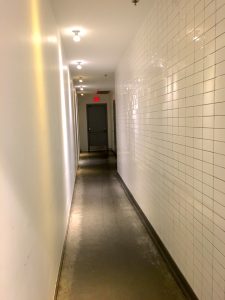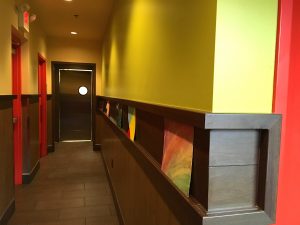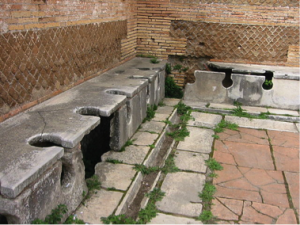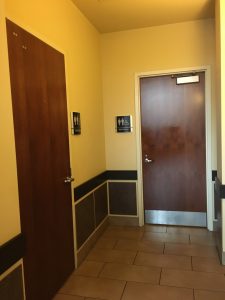
Chipotle’s bathroom, which is relatively hidden from the open eating area and requires the user to walk through a long hallway to access
Like most of the commercial buildings we analyzed, Chipotle’s restrooms are relatively hidden and located near the back of the restaurant. This common location indicates a large intention in our society to keep the act of using the bathroom private and separate from the act of consuming.

Men’s Bathroom in Zoe’s Kitchen is much less accessible than the Women’s
This photo depicts the hallway that leads to the men’s bathroom at Zoe’s Kitchen (it is the door on the back left near the kitchen). To get to the men’s bathroom, a user must walk past the women’s bathroom (you can see a glimpse of the red door on the right of the image), then turn right down a separate hallway to find the men’s bathroom, emphasizing the large amount of privacy between the two gender-specific bathrooms, as well as the easier accessibility for women over men to access the bathroom.

Women’s Bathroom in White Hall with small hallway to give more privacy
As part of our analysis in educational buildings, we looked at the bathrooms in White Hall, where we noticed that one of the main bathrooms has a separate hallway for the women’s bathroom, but just a single, regular door for the men’s bathroom. This example illustrates how often there is more of a need for privacy for women than men, and the design and placement of the bathroom helps to emphasize this.

An ancient public toilet system in Ostia Antica, Italy
As part of our research process, we looked at secondary sources in order to help us compare our current society’s notion of privacy with ancient cities’ notion of privacy in respect to the location of the bathroom. This photo depicts an ancient public toilet system in Ostia Antica, Italy, which shoes the lack of privacy that existed during this time period, and reflects a drastic change in society over history as individual bathrooms (with features such as stalls and urinals) have become the norm.

Gender-Neutral Restrooms in Starbucks
Another aspect of the relationship between privacy and bathrooms that we investigated is the presence of gender-neutral bathrooms, like these bathrooms featured in Starbucks. An increase in the presence of gender-neutral bathrooms across the country reflects changing notions of our need for privacy from other genders, as well as an indicator of increasing values of sympathy and respect towards non-gender conforming or transgender individuals, who often face discrimination when they choose to use the gender-specific bathroom of their choice.